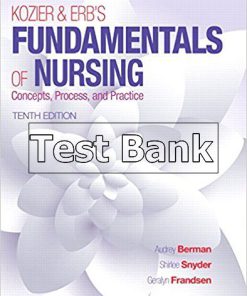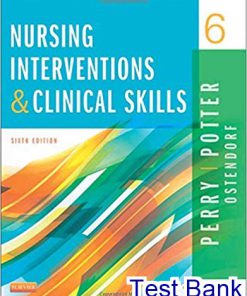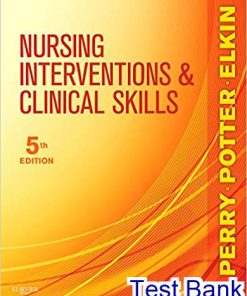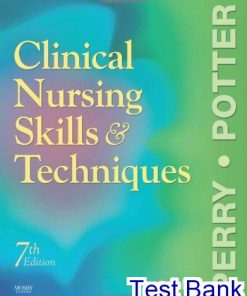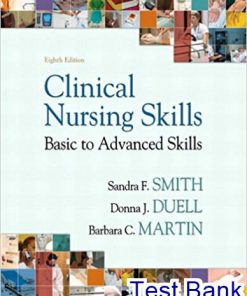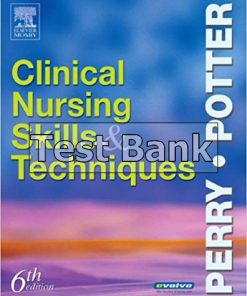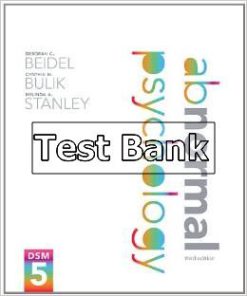Skills in Clinical Nursing 8th Edition Berman Test Bank
You may also like
This is completed downloadable of Skills in Clinical Nursing 8th Edition Berman Test Bank
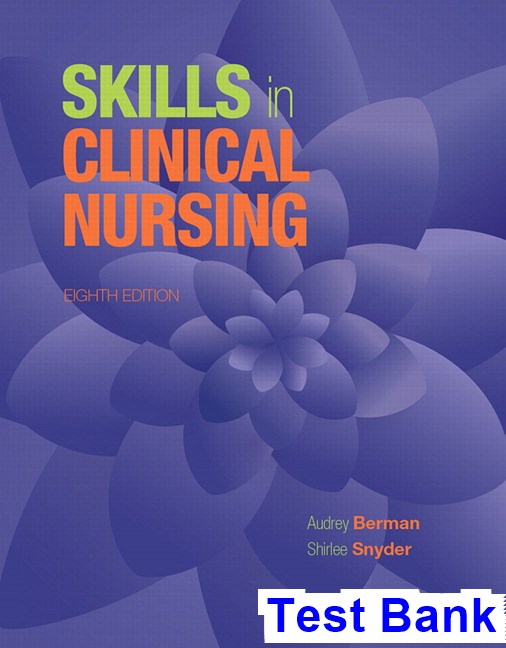
Product Details:
- ISBN-10 : 9780133997439
- ISBN-13 : 978-0133997439
- Author:
Help each student think like a nurse using a clear, consistent presentation of nursing skills
Consistency and accessibility are essential to student success in the Fundamentals of Nursing course. With its clear, approachable, writing style, Skills in Clinical Nursing sets the foundation for nursing excellence. It provides detailed procedures on the most relevant skills performed by nurses as they enter practice. It includes all common variations and is organized from the simplest to the most complex. This edition has been revised and updated to reflect current practice, responding to extensive feedback from clinical nurses, market surveys, and the authors’ own teaching and practice experience. Each chapter contains concise introductory material, placing skills in the context of anatomy, physiology, and pathophysiology, and clearly explaining their purpose and rationale. Each skill is then presented in exceptional step-by-step detail, with over 800 illustrations. Skills coverage is complemented by critical-thinking insights on using assessment data, and essential guidance on appropriate delegation to unlicensed assistive personnel (UAP). Students will learn to think like nurses as they see how the material they are reading is applied in nursing practice.
Table of Content:
- UNIT UNIT 1 Introduction
- 1 Foundational Skills
- KEY TERMS
- Creating and Maintaining the Healing Environment
- CLINICAL ALERT!
- SAFETY Alert!
- Delegation
- Tasks That May Be Delegated to Unlicensed Assistive Personnel
- Tasks That May Not Be Delegated to Unlicensed Assistive Personnel
- Standard Precautions
- Nursing Process: Standard Precautions
- Assessment
- Planning
- DELEGATION
- INTERPROFESSIONAL PRACTICE
- Equipment
- Implementation
- Performance
- Evaluation
- Postexposure Protocol (PEP)
- HIV
- Hepatitis B
- Hepatitis C
- Hand Hygiene
- SAFETY safety Alert!
- Before
- After
- Between
- CLINICAL ALERT!
- CLINICAL ALERT!
- Nursing Process: Hand Hygiene
- Assessment
- Planning
- DELEGATION
- INTERPROFESSIONAL PRACTICE
- Equipment
- Implementation
- Preparation
- Performance
- Evaluation
- Ambulatory and Community Settings Safety
- Personal Protective Equipment
- Gloves
- Gowns
- CLINICAL ALERT!
- Face Masks, Face Shields, Eyewear
- Nursing Process: Personal Protective Equipment
- Assessment
- Planning
- DELEGATION
- INTERPROFESSIONAL PRACTICE
- Equipment
- Implementation
- Preparation
- Performance
- Evaluation
- Ambulatory and Community Settings Safety
- Assisting with Procedures
- Nursing Process: Assisting with Procedures
- Assessment
- Planning
- DELEGATION
- INTERPROFESSIONAL PRACTICE
- Equipment
- Implementation
- Preparation
- Performance
- Evaluation
- Disposal of Soiled Equipment and Supplies
- Bagging
- Linens
- Laboratory Specimens
- Dishes
- Blood Pressure Equipment
- Thermometers
- Disposable Needles, Syringes, and Sharps
- Documentation
- SAFETY safety Alert!
- Goal 2: Improve the Effectiveness of Communication Among Caregivers.
- Chapter 1 Review
- FOCUSING ON CLINICAL THINKING
- Consider This
- TEST YOUR KNOWLEDGE
- Readings and References
- UNIT 1 Applying the Nursing Process
- Medical History:
- Personal and Social History:
- Questions
- UNIT 2 Health Assessment
- 2 Vital Signs
- KEY TERMS
- Body Temperature
- Factors Affecting Body Temperature
- Alterations in Body Temperature
- Pyrexia
- Hypothermia
- Body Temperature Assessment Sites
- Types of Thermometers
- SAFETY ALERT!
- Nursing Process: Assessing Body Temperature
- Assessment
- Planning
- DELEGATION
- INTERPROFESSIONAL PRACTICE
- Equipment
- Implementation
- Preparation
- Performance
- CLINICAL ALERT!
- Evaluation
- Oral
- Rectal
- Axillary
- Tympanic membrane
- Temporal artery
- Infants
- Children
- Older Adults
- Pulse
- Factors Affecting Pulse Rate
- Pulse Assessment Sites
- CLINICAL ALERT!
- Nursing Process: Assessing Peripheral Pulses
- Assessment
- Planning
- DELEGATION
- INTERPROFESSIONAL PRACTICE
- Equipment
- Implementation
- Preparation
- Performance
- Evaluation
- Nursing Process: Assessing an Apical Pulse
- Assessment
- Planning
- DELEGATION
- INTERPROFESSIONAL PRACTICE
- Equipment
- Implementation
- Preparation
- Performance
- CLINICAL ALERT!
- SAMPLE DOCUMENTATION
- Evaluation
- Nursing Process: Assessing an Apical-Radial Pulse
- Assessment
- Planning
- DELEGATION
- INTERPROFESSIONAL PRACTICE
- Equipment
- Implementation
- Preparation
- Performance
- Evaluation
- Infants
- Children
- Older Adults
- Respirations
- Factors Affecting Respirations
- Assessing Respirations
- CLINICAL ALERT!
- Breathing Patterns
- Rate
- Volume
- Rhythm
- Ease or Effort
- Breath Sounds
- Audible Without Amplification
- Chest Movements
- Secretions and Coughing
- Nursing Process: Assessing Respirations
- Assessment
- Planning
- DELEGATION
- INTERPROFESSIONAL PRACTICE
- Equipment
- Implementation
- Preparation
- Performance
- Sample Documentation
- Evaluation
- Infants and Children
- Older Adults
- Ambulatory and Community Settings
- Blood Pressure
- Factors Affecting Blood Pressure
- Blood Pressure Assessment Sites
- Measuring Blood Pressure
- Nursing Process: Assessing Blood Pressure
- Assessment
- Planning
- DELEGATION
- INTERPROFESSIONAL PRACTICE
- Equipment
- Implementation
- Preparation
- Performance
- Variation: Obtaining a Blood Pressure by the Palpation Method
- Variation: Taking a Thigh Blood Pressure
- Variation: Using an Electronic Blood Pressure Monitoring Device (see Figure ❺ on page 43earlier in this skill.)
- Evaluation
- Infants
- Children
- Older Adults
- Oxygen Saturation
- Factors Affecting Oxygen Saturation Readings
- Nursing Process: Assessing Oxygen Saturation
- Assessment
- Planning
- DELEGATION
- INTERPROFESSIONAL PRACTICE
- Equipment
- Implementation
- Preparation
- Performance
- Evaluation
- Infants
- Children
- Older Adults
- Chapter 2 Review
- FOCUSING ON CLINICAL THINKING
- Consider This
- TEST YOUR KNOWLEDGE
- READINGS AND REFERENCES
- 3 Health Assessment
- KEY TERMS
- Nursing Health History
- Biographic Data
- Chief Complaint or Reason for Visit
- History of Present Illness
- Past History
- Family History of Illness
- Lifestyle
- Social Data
- Psychological Data
- Patterns of Health Care
- Physical Health Examination
- General Survey Including Vital Signs
- Eye Contact
- Touch and Personal Space
- Use of Body Language
- Examination Techniques
- Inspection
- Palpation
- Percussion
- Auscultation
- General Survey
- General Appearance and Mental Status
- CLINICAL ALERT!
- Vital Signs
- Height and Weight
- Nursing Process: Assessing Appearance and Mental Status
- Planning
- DELEGATION
- INTERPROFESSIONAL PRACTICE
- Equipment
- Implementation
- Performance
- Evaluation
- Infants
- Children
- Older Adults (Over Age 65)
- Integument
- Skin
- Nursing Process: Assessing the Skin
- Planning
- DELEGATION
- INTERPROFESSIONAL PRACTICE
- Equipment
- Implementation
- Performance
- Evaluation
- Infants
- Children
- Older Adults
- Hair
- Nursing Process: Assessing the Hair
- Planning
- DELEGATION
- INTERPROFESSIONAL PRACTICE
- Equipment
- Implementation
- Performance
- Evaluation
- Infants
- Children
- Older Adults
- Nails
- Nursing Process: Assessing the Nails
- Planning
- DELEGATION
- INTERPROFESSIONAL PRACTICE
- Equipment
- Implementation
- Performance
- Evaluation
- Infants
- Children
- Older Adults
- Head
- Skull and Face
- Nursing Process: Assessing the Skull and Face
- Planning
- DELEGATION
- INTERPROFESSIONAL PRACTICE
- Equipment
- Implementation
- Performance
- Evaluation
- Infants
- Eyes and Vision
- Nursing Process: Assessing the Eyes and Vision
- Planning
- DELEGATION
- INTERPROFESSIONAL PRACTICE
- Equipment
- Implementation
- Performance
- Evaluation
- Infants
- Children
- Older Adults
- Visual Acuity
- External Eye Structures
- Ears and Hearing
- Nursing Process: Assessing the Ears and Hearing
- Planning
- DELEGATION
- INTERPROFESSIONAL PRACTICE
- Equipment
- Implementation
- Performance
- Evaluation
- Infants
- Children
- Older Adults
- Nose and Sinuses
- Nursing Process: Assessing the Nose and Sinuses
- Planning
- DELEGATION
- INTERPROFESSIONAL PRACTICE
- Equipment
- Implementation
- Performance
- Evaluation
- Infants
- Children
- Older Adults
- Mouth and Oropharynx
- Nursing Process: Assessing the Mouth and Oropharynx
- Planning
- DELEGATION
- INTERPROFESSIONAL PRACTICE
- Equipment
- Implementation
- Performance
- Evaluation
- Infants
- Children
- Older Adults
- Neck
- Nursing Process: Assessing the Neck
- Planning
- DELEGATION
- INTERPROFESSIONAL PRACTICE
- Equipment
- Implementation
- Performance
- Evaluation
- Infants and Children
- Thorax and Lungs
- Chest Wall Landmarks
- Chest Shape and Size
- Breath Sounds
- Nursing Process: Assessing the Thorax and Lungs
- Planning
- DELEGATION
- INTERPROFESSIONAL PRACTICE
- Equipment
- Implementation
- Performance
- Evaluation
- Infants
- Children
- Older Adults
- The Cardiovascular and Peripheral Vascular Systems
- Heart
- CLINICAL ALERT!
- Central Vessels
- Nursing Process: Assessing the Heart and Central Vessels
- Planning
- DELEGATION
- INTERPROFESSIONAL PRACTICE
- Equipment
- Implementation
- Performance
- Evaluation
- Infants
- Children
- Older Adults
- Peripheral Vascular System
- Nursing Process: Assessing the Peripheral Vascular System
- Planning
- DELEGATION
- INTERPROFESSIONAL PRACTICE
- Equipment
- Implementation
- Performance
- Evaluation
- Infants
- Children
- Older Adults
- Breasts and Axillae
- Breast Self-Examination
- Clinical Breast Examination by a Health Care Professional
- Mammography
- Women at Increased Risk
- Nursing Process: Assessing the Breasts and Axillae
- Planning
- DELEGATION
- INTERPROFESSIONAL PRACTICE
- Equipment
- Implementation
- Performance
- Evaluation
- Infants
- Children
- Pregnant Females
- Older Adults
- Inspection Before a Mirror
- Palpation: Lying Position
- Palpation: Standing or Sitting
- Abdomen
- Right Upper Quadrant
- Right Lower Quadrant
- Left Upper Quadrant
- Left Lower Quadrant
- Right Hypochondriac
- Right Lumbar
- Right Inguinal
- Epigastric
- Umbilical
- Hypogastric (Pubic)
- Left Hypochondriac
- Left Lumbar
- Left Inguinal
- Nursing Process: Assessing the Abdomen
- Planning
- DELEGATION
- INTERPROFESSIONAL PRACTICE
- Equipment
- Implementation
- Performance
- Evaluation
- Infants
- Children
- Older Adults
- Musculoskeletal System
- Nursing Process: Assessing the Musculoskeletal System
- Planning
- DELEGATION
- INTERPROFESSIONAL PRACTICE
- Equipment
- Implementation
- Performance
- Evaluation
- Infants
- Children
- Older Adults
- Neurologic System
- Nursing Process: Assessing the Neurologic System
- Planning
- DELEGATION
- INTERPROFESSIONAL PRACTICE
- Equipment (Depending on Components of Examination)
- Implementation
- Performance
- CLINICAL ALERT!
- Motor Function
- Evaluation
- Infants
- Children
- Older Adults
- Female Genitals and Inguinal Area
- Nursing Process: Assessing the Female Genitals and Inguinal Area
- Planning
- DELEGATION
- INTERPROFESSIONAL PRACTICE
- Equipment
- Implementation
- Performance
- Evaluation
- Infants
- Children
- Older Adults
- Male Genitals and Inguinal Area
- Nursing Process: Assessing the Male Genitals and Inguinal Area
- Planning
- DELEGATION
- INTERPROFESSIONAL PRACTICE
- Equipment
- Implementation
- Performance
- Evaluation
- Infants
- Children
- Older Adults
- Anal Area
- Nursing Process: Assessing the Anus
- Planning
- DELEGATION
- INTERPROFESSIONAL PRACTICE
- Equipment
- Implementation
- Performance
- Evaluation
- Infants
- Children
- Older Adults
- Fluid Balance
- Current and Past Medical History
- Medications and Treatments
- Food and Fluid Intake
- Fluid Output
- Fluid Imbalances
- Daily Weights
- Vital Signs
- Fluid Intake and Output
- Nursing Process: Assessing Fluid Balance
- Planning
- DELEGATION
- INTERPROFESSIONAL PRACTICE
- Equipment
- Implementation
- Performance
- Evaluation
- Monitoring Fluid Intake and Output
- Maintaining Fluid Intake
- Helping Clients Increase Fluid Intake
- Helping Clients Restrict Fluid Intake
- Referrals
- Client
- Family
- Chapter 3 Review
- FOCUSING ON CLINICAL THINKING
- Consider This
- TEST YOUR KNOWLEDGE
- READINGS AND REFERENCES
- 4 Diagnostic Testing
- KEY TERMS
- Diagnostic Testing Phases
- Pretest
- Intratest
- Post-Test
- Specimen Collection
- Capillary Blood Glucose (CBG)
- Nursing Process: Measuring Capillary Blood Glucose
- Assessment
- Planning
- DELEGATION
- Equipment
- Implementation
- Preparation
- Performance
- Evaluation
- Infants
- Children
- Older Adults
- Stool Specimens
- Nursing Process: Stool Specimens and Tests
- Assessment
- Planning
- DELEGATION
- Equipment
- Implementation
- Preparation
- Performance
- Evaluation
- Infants
- Children
- Older Adults
- Using a Hemoccult Test
- Using a Fit
- Urine Specimens
- Routine Urine Specimen
- Timed Urine Specimen
- Clean-Catch or Midstream Urine Specimen
- Urine Tests
- CLINICAL ALERT!
- Collecting a Routine Urine Specimen
- Nursing Process: Routine Urine Specimen
- Assessment
- Planning
- DELEGATION
- Equipment
- Implementation
- Preparation
- Performance
- Evaluation
- Infants
- Children
- Older Adults
- Collecting a Timed Urine Specimen
- Nursing Process: Timed Urine Specimen
- Assessment
- Planning
- DELEGATION
- Equipment
- Implementation
- Preparation
- Performance
- Evaluation
- Collecting a Urine Specimen for Culture and Sensitivity by Clean Catch
- Nursing Process: Urine Specimen for Culture and Sensitivity
- Assessment
- Planning
- DELEGATION
- Equipment
- Implementation
- Preparation
- Performance
- SAMPLE DOCUMENTATION
- Variation: Obtaining a Urine Specimen from a Closed Drainage System
- Evaluation
- Nursing Process: Urine Testing
- Assessment
- Planning
- DELEGATION
- Equipment
- Implementation
- Preparation
- Performance
- Evaluation
- Sputum, Nose, and Throat Specimens
- Nursing Process: Sputum Specimen
- Assessment
- Planning
- DELEGATION
- Equipment
- Implementation
- Preparation
- Performance
- Evaluation
- Older Adults
- Nose and Throat Specimens
- Nursing Process: Nose and Throat Specimens
- Assessment
- Planning
- DELEGATION
- Equipment
- Implementation
- Preparation
- Performance
- Variation: Obtaining a Nasopharyngeal Culture
- Evaluation
- Infants
- Children
- Wound Drainage Specimen
- Kinds of Wound Drainage
- Nursing Process: Wound Drainage Specimen
- Assessment
- Planning
- DELEGATION
- Equipment
- Implementation
- Preparation
- Performance
- SAMPLE DOCUMENTATION
- Variation: Obtaining a Specimen for Anaerobic Culture Using a Sterile Syringe and Needle
- Evaluation
- Aspiration and Biopsy Procedures
- CLINICAL ALERT!
- Lumbar Puncture
- Children
- Older Adults
- Abdominal Paracentesis
- Thoracentesis
- Older Adults
- Older Adults
- Bone Marrow Biopsy
- Children
- Older Adults
- Liver Biopsy
- Older Adults
- CLINICAL ALERT!
- Care of Clients Receiving Contrast Media
- CLINICAL ALERT!
- Client Preparation
- Post-Test
- Chapter 4 Review
- FOCUSING ON CLINICAL THINKING
- Consider This
- TEST YOUR KNOWLEDGE
- READINGS AND REFERENCES
- UNIT 2 Applying the Nursing Process
- Medical History:
- Personal and Social History:
- Questions
- Assessment
- Analysis
- Planning
- Implementation
- Evaluation
- UNIT 3 Assisting with Client Hygiene and Comfort
- 5 Client Hygiene
- KEY TERMS
- Bathing and Skin Care
- Categories of Baths
- Long-Term Care Setting
- Nursing Process: Bathing and Skin Care
- Assessment
- Planning
- DELEGATION
- Equipment
- Implementation
- Preparation
- Performance
- Variation: Bathing Using a Hydraulic Bathtub Chair
- Evaluation
- Infants
- Children
- Adolescents
- Older Adults
- Dry Skin
- Skin Rashes
- Acne
- Safety Ambulatory and Community Settings
- Perineal-Genital Care
- CLINICAL ALERT!
- Nursing Process: Providing Perineal-Genital Care
- Assessment
- Planning
- DELEGATION
- Equipment
- Implementation
- Preparation
- Performance
- Evaluation
- Oral Hygiene
- Clients at Risk
- CLINICAL ALERT!
- Special Oral Hygiene
- Nursing Process: Oral Hygiene
- Assessment
- Planning
- DELEGATION
- Equipment
- Implementation
- Preparation
- Performance
- Variation: Cleaning Artificial Dentures
- Implementation
- Performance
- Evaluation
- Infants
- Children
- Older Adults
- Hair Care
- Brushing and Combing Hair
- CLINICAL ALERT!
- Shampooing the Hair
- Beard and Mustache Care
- CLINICAL ALERT!
- Nursing Process: Providing Hair Care
- Assessment
- Planning
- DELEGATION
- Equipment
- Implementation
- Performance
- Variation: Providing Hair Care for African American Clients
- Evaluation
- Infants
- Children
- Older Adults
- Foot Care
- CLINICAL ALERT!
- CLINICAL ALERT!
- Nursing Process: Providing Foot Care
- Assessment
- Planning
- DELEGATION
- Equipment
- Implementation
- Preparation
- Performance
- Evaluation
- Ears
- Cleaning the Ears
- Care of Hearing Aids
- Nursing Process: Ears
- Assessment
- Planning
- DELEGATION
- Equipment
- Implementation
- Performance
- Evaluation
- Chapter 5 Review
- FOCUSING ON CLINICAL THINKING
- Consider This
- TEST YOUR KNOWLEDGE
- READINGS AND REFERENCES
- 6 Bed-Making
- KEY TERMS
- Supporting a Hygienic and Comfortable Environment
- Room Temperature
- Ventilation
- Noise
- Hospital Beds
- Mattresses
- Side Rails
- SAFETY Safety Alert!
- Footboards
- Intravenous Rods
- Making Beds
- Unoccupied Bed
- Nursing Process: Making Beds
- Assessment
- Planning
- Delegation
- Equipment
- Implementation
- Preparation
- Performance
- Variation: Making a Surgical Bed
- Evaluation
- Occupied Bed
- Nursing Process: Occupied Beds
- Assessment
- Planning
- Delegation
- Equipment
- Implementation
- Preparation
- Performance
- Evaluation
- Children
- Older Adults
- Chapter 6 Review
- Focusing on Clinical Thinking
- Consider This
- Test Your Knowledge
- Readings and References
- 7 Infection Prevention
- KEY TERMS
- Chain of Infection
- SAFETY Safety Alert!
- Method of Transmission
- Breaking the Chain of Infection
- Reducing Risks for Infection
- SAFETY Safety Alert!
- Goal 7: Reduce the Risk of Health Care–Associated Infections.
- Maintaining Surgical Asepsis
- Sterile Field
- Nursing Process: Establishing and Maintaining a Sterile Field
- Assessment
- Planning
- DELEGATION
- INTERPROFESSIONAL PRACTICE
- Equipment
- Implementation
- Preparation
- Performance
- To Open a Wrapped Package on a Surface
- Variation: Opening a Wrapped Package While Holding It
- Variation: Opening Commercially Prepared Packages
- Adding Wrapped Supplies to a Sterile Field
- Variation: Adding Commercially Packaged Supplies to a Sterile Field
- Adding Solution to a Sterile Bowl
- Evaluation
- Sterile Gloves
- Nursing Process: Applying and Removing Sterile Gloves
- Assessment
- Planning
- DELEGATION
- INTERPROFESSIONAL PRACTICE
- Equipment
- Implementation
- Preparation
- Performance
- Evaluation
- Caring for Clients with Known or Suspected Infections
- Standard Precautions (see Chapter 1 )
- Transmission-Based Precautions (see Skill 7–3)
- Nursing Process: Caring for Clients with Known or Suspected Infections
- Assessment
- Planning
- DELEGATION
- INTERPROFESSIONAL PRACTICE
- Equipment
- Implementation
- Performance
- Evaluation
- CHILDREN
- OLDER ADULTS
- Chapter 7 Review
- FOCUSING ON CLINICAL THINKING
- Consider This
- TEST YOUR KNOWLEDGE
- READINGS AND REFERENCES
- 8 Heat and Cold Measures
- KEY TERMS
- Guidelines for Applying Heat and Cold
- Adaptation of Thermal Receptors
- Rebound Phenomenon
- Systemic Effects
- Tolerance and Contraindications
- The Mind–Body Connection
- Nursing Process: Applying Heat or Cold
- Assessment
- Planning
- DELEGATION
- INTERPROFESSIONAL PRACTICE
- Equipment
- Hot Water Bottle (Bag)
- Electric Heating Pad
- Aquathermia Pad
- Disposable Hot Pack
- Implementation
- Preparation
- Performance
- Variation: Hot Water Bottle (Most commonly used in the home setting)
- Variation: Electric Heating Pad (Most commonly used in the home setting)
- Variation: Aquathermia Pad (Also called a K-Pad) ❷
- Variation: Disposable Hot Pack ❸
- Evaluation
- Infant/Child
- Older Adults
- Assessment
- Planning
- DELEGATION
- INTERPROFESSIONAL PRACTICE
- Equipment
- CLINICAL ALERT!
- Implementation
- Preparation
- Performance
- Variation: Ice Bag, Collar, or Glove ❶
- Variation: Disposable Cold Pack ❷
- CLINICAL ALERT!
- SAMPLE DOCUMENTATION
- Evaluation
- Compresses and Moist Packs
- Assessment
- Planning
- DELEGATION
- INTERPROFESSIONAL PRACTICE
- Equipment
- Implementation
- Preparation
- Performance
- Evaluation
- Chapter 8 Review
- FOCUSING ON CLINICAL THINKING
- Consider This
- TEST YOUR KNOWLEDGE
- READINGS AND REFERENCES
- 9 Pain Management
- KEY TERMS
- The Nature of Pain
- Types of Pain
- Location
- Duration
- Intensity
- Etiology
- Concepts Associated with Pain
- Factors Affecting the Pain Experience
- Ethnic and Cultural Values
- African Americans
- Hispanic/Latino
- Asian Americans
- Native Americans
- Arab Americans
- Developmental Stage
- Environment and Support People
- Previous Pain Experiences
- Meaning of Pain
- Emotional Responses to Pain
- Barriers to Pain Management
- Key Strategies in Pain Management
- Acknowledging and Accepting the Client’s Pain
- CLINICAL ALERT!
- Assisting Support People
- Reducing Misconceptions About Pain
- Reducing Fear and Anxiety
- Preventing Pain
- Pain Assessment
- CLINICAL ALERT!
- Pain History
- Location
- Pain Intensity or Rating Scales
- CLINICAL ALERT!
- Pain Quality
- Pattern
- Precipitating Factors
- Alleviating Factors
- Associated Symptoms
- Effect on Activities of Daily Living
- Coping Resources
- Affective Responses
- Observation of Behavioral and Physiological Responses
- Daily Pain Diary
- Nursing Process: Assessing the Client in Pain
- Planning
- DELEGATION
- Equipment
- Implementation
- Preparation
- Performance
- SAMPLE DOCUMENTATION
- Variation: Daily Pain Diary
- Evaluation
- Client
- Family
- Community
- Pain Management
- Recommendations:
- Prescriber:
- Nurses:
- Pain Control
- Resources
- Pharmacologic Pain Management
- Nonopioid Analgesics/NSAIDs
- Opioid Analgesics for Moderate Pain
- Opioid Analgesics for Severe Pain
- Coanalgesics
- World Health Organization Three-Step Analgesic Ladder
- CLINICAL ALERT!
- Nonopioids/NSAIDs
- CLINICAL ALERT!
- Opioids
- Opioid Analgesics for Moderate Pain
- Opioid Analgesics for Severe Pain
- Opioid Side Effects
- Constipation
- Nausea and Vomiting
- Sedation
- Respiratory Depression
- Pruritus
- Urinary Retention
- CLINICAL ALERT!
- SAFETY Safety Alert!
- Equianalgesic Dosing
- SAFETY Safety Alert!
- Coanalgesics
- Administration of Placebos
- Routes for Opioid Delivery
- Oral
- Transnasal
- Transdermal
- Transmucosal
- Topical
- Rectal
- Subcutaneous
- Intramuscular
- Intravenous
- Intraspinal
- Continuous Local Anesthetics
- Patient-Controlled Analgesia
- Nursing Process: Patient-Controlled Analgesia Pump
- Assessment
- Planning
- DELEGATION
- Equipment
- Implementation
- Preparation
- Performance
- Evaluation
- Children
- Older Adults
- Safety Ambulatory and Community Settings
- Nonpharmacologic Pain Management
- Physical Interventions
- Transcutaneous Electrical Nerve Stimulation
- Nursing Process: Transcutaneous Electrical Nerve Stimulation
- Assessment
- Planning
- DELEGATION
- Equipment
- Implementation
- Performance
- SAMPLE DOCUMENTATION
- Evaluation
- Massage
- Nursing Process: Back Massage
- Assessment
- Planning
- DELEGATION
- Equipment
- Implementation
- Preparation
- Performance
- SAMPLE DOCUMENTATION
- Evaluation
- Cognitive–Behavioral Pain Management Strategies
- Distraction
- Eliciting the Relaxation Response
- Visual Distraction
- Auditory Distraction
- Tactile Distraction
- Intellectual Distraction
- Repatterning Unhelpful Thinking
- Facilitating Coping
- Selected Spiritual Interventions
- Infant
- Child
- Older Adults
- Nursing Process: Cognitive–Behavioral Pain Management Strategies
- Assessment
- Planning
- DELEGATION
- Equipment
- Implementation
- Preparation
- Performance
- SAMPLE DOCUMENTATION
- Evaluation
- Implementation
- Preparation
- Performance
- Evaluation
- Chapter 9 Review
- FOCUSING ON CLINICAL THINKING
- Consider This
- TEST YOUR KNOWLEDGE
- READINGS AND REFERENCES
- UNIT 3 Applying the Nursing Process
- Medical History:
- Personal and Social History:
- Questions
- Assessment
- Analysis
- Planning
- Implementation
- Evaluation
- UNIT 4 Mobility and Safety
- 10 Positioning the Client
- KEY TERMS
- Body Mechanics
- SAFETY Safety Alert!
- Elements of Body Movement
- Body Alignment and Posture
- Balance
- Coordinated Body Movement
- Principles of Body Mechanics
- Lifting
- Pulling and Pushing
- CLINICAL ALERT!
- Pivoting
- Preventing Back Injury
- Positioning Clients in Bed
- Fowler’s Position
- Orthopneic Position
- Dorsal Recumbent Position
- Prone Position
- Measures to Promote Alignment and Comfort*
- Measures to Promote Alignment and Support*
- Measures to Promote Alignment and Support*
- Lateral Position
- Measures to Promote Alignment and Support*
- Sims’ Position
- Measures to Promote Alignment and Support*
- Nursing Process: Positioning Clients in Bed
- Assessment
- Planning
- DELEGATION
- Equipment
- Implementation
- Preparation
- Performance
- Supporting a Client in Fowler’s Position
- Supporting a Client in the Dorsal Recumbent Position
- Supporting a Client in the Prone Position
- Supporting a Client in the Lateral Position
- Supporting a Client in Sims’ Position
- SAMPLE DOCUMENTATION
- Evaluation
- Moving and Turning Clients in Bed
- CLINICAL ALERT!
- Nursing Process: Moving and Turning Clients in Bed
- Assessment
- Planning
- DELEGATION
- Equipment
- Implementation
- Preparation
- Performance
- Implementation
- Preparation
- Performance
- Variation: Turning the Client to a Prone Position
- Implementation
- Preparation
- Performance
- Implementation
- Preparation
- Performance
- Evaluation
- Infants
- Children
- Older Adults
- Transferring Clients
- CLINICAL ALERT!
- Nursing Process: Transferring Clients
- Assessment
- Planning
- DELEGATION
- Equipment
- Implementation
- Preparation
- Performance
- Variation: Transferring with a Belt and Two Nurses
- Variation: Transferring a Client with an Injured Lower Extremity
- Variation: Using a Slide Board
- Evaluation
- Transferring Between Bed and Stretcher
- Nursing Process: Transferring Between Bed and Stretcher
- Assessment
- Planning
- DELEGATION
- Equipment
- Implementation
- Preparation
- Performance
- Variation: Using a Transfer Board
- Evaluation
- SAMPLE DOCUMENTATION
- Infants
- Children
- Older Adults
- Lifting Devices
- Nursing Process: Hydraulic Lifts
- Assessment
- Planning
- DELEGATION
- Equipment
- Implementation
- Preparation
- Performance
- Evaluation
- Specialized Beds
- CLINICAL ALERT!
- Child
- Older Adults
- Chapter 10 Review
- FOCUSING ON CLINICAL THINKING
- Consider This
- TEST YOUR KNOWLEDGE
- READINGS AND REFERENCES
- 11 Mobilizing the Client
- KEY TERMS
- Assisting Clients to Use Wheelchairs
- Nursing Process: Wheelchairs
- Assessment
- Planning
- DELEGATION
- Equipment
- Implementation
- Performance
- Evaluation
- Children
- Older Adults
- Safety Ambulatory and Community Settings
- Ambulation
- Nursing Process: Ambulation
- Assessment
- Planning
- DELEGATION
- INTERPROFESSIONAL PRACTICE
- Equipment
- Implementation
- Preparation
- Performance
- Variation: Two Nurses
- SAMPLE DOCUMENTATION
- Evaluation
- Children
- Older Adults
- Safety Ambulatory and Community Settings
- Assisting Clients to Use Mechanical Aids for Walking
- Nursing Process: Assisting Clients to Use Mechanical Aids for Walking
- Assessment
- Planning
- DELEGATION
- INTERPROFESSIONAL PRACTICE
- Equipment
- Implementation
- Preparation
- Performance
- CLINICAL ALERT!
- Implementation
- Preparation
- Performance
- Four-Point Alternate Gait
- Three-Point Gait
- Two-Point Alternate Gait
- Swing-To Gait
- Swing-Through Gait
- Getting Into a Chair
- Getting Out of a Chair
- Going Up Stairs
- Going Down Stairs
- SAMPLE DOCUMENTATION
- Implementation
- Preparation
- Performance
- Evaluation
- SAFETY Safety Alert!
- Children
- Older Adults
- Safety Ambulatory and Community Settings
- Chapter 11 Review
- FOCUSING ON CLINICAL THINKING
- Consider This
- TEST YOUR KNOWLEDGE
- READINGS AND REFERENCES
- 12 Fall Prevention and Restraints
- KEY TERMS
- Preventing Falls
- CLINICAL ALERT!
- Infants/Children
- Older Adults
- ●◯● Nursing Process: Preventing Falls
- Assessment
- Planning
- DELEGATION
- INTERPROFESSIONAL PRACTICE
- Equipment
- Implementation
- Performance
- SAMPLE DOCUMENTATION
- Evaluation
- Safety Ambulatory and Community Settings
- Restraining Clients
- Selecting a Restraint
- Nursing Process: Restraining Clients
- Assessment
- Planning
- DELEGATION
- Equipment
- Implementation
- Performance
- Belt Restraint (Safety Belt)
- Vest Restraint
- Mitt Restraint
- Wrist or Ankle Restraint
- SAMPLE DOCUMENTATION
- Evaluation
- Infants
- Children
- Safety Ambulatory and Community Settings
- CLINICAL ALERT!
- Seizure Precautions
- Nursing Process: Seizure Precautions
- Assessment
- Planning
- DELEGATION
- Equipment
- Implementation
- Performance
- SAMPLE DOCUMENTATION
- Evaluation
- Infants
- Children
- Safety Ambulatory and Community Settings
- Chapter 12 Review
- FOCUSING ON CLINICAL THINKING
- Consider This
- TEST YOUR KNOWLEDGE
- READINGS AND REFERENCES
- 13 Maintaining Joint Mobility
- KEY TERMS
- Range-of-Motion Exercises
- Active Range of Motion
- Older Adults
- Children
- Passive Range of Motion
- Active-Assistive Range of Motion
- CLINICAL ALERT!
- Nursing Process: Range-of-Motion Exercises
- Assessment
- Planning
- DELEGATION
- INTERPROFESSIONAL PRACTICE
- Equipment
- Implementation
- Preparation
- Performance
- SAMPLE DOCUMENTATION
- Evaluation
- Children
- Older Adults
- Continuous Passive Motion Devices
- ●◯● Nursing Process: Continuous Passive Motion Devices
- Assessment
- Planning
- DELEGATION
- INTERPROFESSIONAL PRACTICE
- Equipment
- Implementation
- Preparation
- Performance
- SAMPLE DOCUMENTATION
- Evaluation
- Children
- Older Adults
- Chapter 13 Review
- FOCUSING ON CLINICAL THINKING
- Consider This
- TEST YOUR KNOWLEDGE
- Readings and References
- UNIT 4 Applying the Nursing Process
- Medical History:
- Personal and Social History:
- Questions
- Assessment
- Analysis
- Planning
- Implementation
- Evaluation
- UNIT 5 Medication Administration
- 14 Drug Calculations
- KEY TERMS
- Systems of Measurement
- Metric System
- Apothecaries’ System
- Household System
- Converting Units of Weight and Measure
- Converting Weights within the Metric System
- Practice A
- Converting Weights and Measures between Systems
- Converting Units of Volume
- Practice B
- Converting Units of Weight
- Practice C
- Methods of Calculating Dosages
- Basic Formula
- Oral Medications
- Parenteral Medications
- IV Infusion
- Rounding Down
- Example
- Another Example
- Ratio and Proportion Method
- Example
- Another Example
- Fractional Equation Method
- Example
- Example Requiring Conversion
- Dimensional Analysis Method
- Example
- Example Using a Conversion Factor
- Another Example Requiring Conversion
- Calculation for Individualized Drug Dosages
- Body Weight
- Example
- Body Surface Area
- Calculating Intravenous Flow Rates
- Calculating Milliliters per Hour
- Example
- Calculating Drops per Minute
- Calculating IV Flow Rates Based on Time
- Ratio and Proportion Method
- Basic Formula Method
- Dimensional Analysis Method
- Calculating IV Flow Rates Based on Body Weight and Time
- Chapter 14 Review
- FOCUSING ON CLINICAL THINKING
- Consider This
- TEST YOUR KNOWLEDGE
- READINGS AND REFERENCES
- 15 Administering Oral and Enteral Medications
- KEY TERMS
- Legal Aspects of Drug Administration
- Effects of Drugs
- Routes of Administration
- Oral
- Sublingual
- Buccal
- Enteral
- Medication Orders
- SAFETY Safety Alert!
- Types of Medication Orders
- Essential Parts of a Drug Order
- Implications for Nursing Interventions
- Communicating a Medication Order
- CLINICAL ALERT!
- Administering Medications Safely
- Medication Administration Errors
- Medication Reconciliation
- SAFETY Safety Alert!
- Goal 3: Maintain and Communicate Accurate Client Medication Information.
- Medication Dispensing Systems
- Process of Administering Medications
- SAFETY Safety Alert!
- Goal 1: Improve the Accuracy of Patient Identification.
- CLINICAL ALERT!
- First Check
- Second Check
- Third Check
- Right Medication
- Right Dose
- Right Time
- Right Route
- Right Client
- Right Client Education
- Right Documentation
- Right to Refuse
- Right Assessment
- Right Evaluation
- Oral Medications
- Nursing Process: Oral Medications
- Assessment
- Planning
- DELEGATION
- Equipment
- Implementation
- Preparation
- Performance
- Tablets or Capsules
- CLINICAL ALERT!
- Liquid Medication
- SAFETY Safety Alert!
- Goal 3: Improve the Safety of Using Medications.
- Oral Narcotics
- All Medications
- Evaluation
- Infants
- Children
- Older Adults
- Nasogastric and Gastrostomy Medications
- Nursing Process: Nasogastric and Gastrostomy Medications
- Assessment
- Planning
- DELEGATION
- Equipment
- Implementation
- Preparation
- Performance
- Evaluation
- Chapter 15 Review
- FOCUSING ON CLINICAL THINKING
- Consider This
- TEST YOUR KNOWLEDGE
- READINGS AND REFERENCES
- 16 Administering Topical Medications
- KEY TERMS
- CLINICAL ALERT!
- Dermatologic Medications
- Transdermal Medications
- Powder
- Suspension-Based Lotion
- Creams, Ointments, Pastes, and Oil-Based Lotions
- Aerosol Spray
- Transdermal Patches
- CLINICAL ALERT!
- Nursing Process: Dermatologic Medications
- Assessment
- Planning
- DELEGATION
- Equipment
- Implementation
- Preparation
- Performance
- Evaluation
- Ophthalmic Medications
- Nursing Process: Ophthalmic Medications
- Assessment
- Planning
- DELEGATION
- Equipment
- Implementation
- Preparation
- Performance
- Variation: Eye Irrigation
- Evaluation
- Infants/Children
- Otic Medications
- Nursing Process: Otic Medications
- Assessment
- Planning
- DELEGATION
- Equipment
- Implementation
- Preparation
- Performance
- Variation: Ear Irrigation
- Evaluation
- Infants/Children
- Nasal Medications
- Nursing Process: Nasal Medications
- Assessment
- Planning
- DELEGATION
- Equipment
- Implementation
- Preparation
- Performance
- Evaluation
- Inhaled Medications
- CLINICAL ALERT!
- Nursing Process: Inhaled Medications
- Assessment
- Planning
- DELEGATION
- Equipment
- Implementation
- Preparation
- Performance
- Metered-Dose Inhaler
- Metered-Dose Inhaler with Spacer
- Administering the Medication
- CLINICAL ALERT!
- CLINICAL ALERT!
- Evaluation
- Children
- Vaginal Medications
- Nursing Process: Vaginal Medications
- Assessment
- Planning
- DELEGATION
- Equipment
- Implementation
- Preparation
- Performance
- Suppository
- Vaginal Cream, Jelly, or Foam
- Irrigation
- Evaluation
- Rectal Medications
- Nursing Process: Rectal Medications
- Assessment
- Planning
- DELEGATION
- Equipment
- Implementation
- Preparation
- Performance
- Evaluation
- Infants/Children
- Chapter 16 Review
- FOCUSING ON CLINICAL THINKING
- Consider This
- TEST YOUR KNOWLEDGE
- READINGS AND REFERENCES
- 17 Administering Parenteral Medications
- KEY TERMS
- Equipment
- Syringes
- Needles
- Preventing Needlestick Injuries
- Preparing Injectable Medications
- Ampules and Vials
- CLINICAL ALERT!
- Nursing Process: Preparing Injectable Medications
- Assessment
- Planning
- DELEGATION
- Equipment
- Implementation
- Preparation
- Performance
- Planning
- DELEGATION
- Equipment
- Implementation
- Preparation
- Performance
- Variation: Preparing and Using Multidose Vials
- Mixing Medications in One Syringe
- ●◯● Nursing Process: Mixing Medications in One Syringe
- Assessment
- Planning
- DELEGATION
- Equipment
- Implementation
- Preparation
- Performance
- Mixing Medications from Two Vials
- Mixing Medications from One Vial and One Ampule
- Mixing Medications from One Cartridge and One Vial or Ampule
- Variation: Mixing Insulins
- CLINICAL ALERT!
- Intradermal Injections
- Nursing Process: Intradermal Injections
- Assessment
- Planning
- DELEGATION
- Equipment
- Implementation
- Preparation
- Performance
- Evaluation
- Children
- Subcutaneous Injections
- Nursing Process: Subcutaneous Injections
- Assessment
- Planning
- DELEGATION
- Equipment
- Implementation
- Preparation
- Performance
- CLINICAL ALERT!
- Variation: Administering a Heparin Injection
- Variation: Administering Enoxaparin (Lovenox)
- Evaluation
- Intramuscular Injections
- Ventrogluteal Site
- Vastus Lateralis Site
- Dorsogluteal Site
- Rectus Femoris Site
- Deltoid Site
- Intramuscular Injection Technique
- Nursing Process: Intramuscular Injections
- Assessment
- Planning
- DELEGATION
- Equipment
- Implementation
- Preparation
- Performance
- Evaluation
- Infants
- Children
- Older Adults
- Intravenous Medications
- Large-Volume Infusions
- Nursing Process: Large-Volume Infusions
- Assessment
- Planning
- DELEGATION
- Equipment
- Implementation
- Preparation
- Performance
- To New IV Container
- To an Existing Infusion
- Evaluation
- Intermittent Intravenous Infusions
- ●◯● Nursing Process: Intermittent Intravenous Infusions
- Assessment
- Planning
- DELEGATION
- Equipment
- Implementation
- Preparation
- Performance
- CLINICAL ALERT
- Variation: Using a Saline Lock
- Variation: Adding a Medication to a Volume-Control Infusion
- Evaluation
- Intravenous Push
- CLINICAL ALERT!
- Nursing Process: Intravenous Push
- Assessment
- Planning
- DELEGATION
- Equipment
- IV Push for an Existing Line
- IV Push for an IV Lock
- Implementation
- Preparation
- Performance
- Existing Line
- IV Lock
- IV Lock with Needle
- IV Lock with Needleless System
- Existing Line
- Evaluation
- Chapter 17 Review
- FOCUSING ON CLINICAL THINKING
- Consider This
- TEST YOUR KNOWLEDGE
- READINGS AND REFERENCES
- 18 Administering Intravenous Therapy
- KEY TERMS
- Intravenous Infusions
- Common Types of Solutions
- Peripheral Venipuncture Sites
- Intravenous Infusion Equipment
- Intravenous Catheters
- CLINICAL ALERT!
- Catheter Stabilization Devices
- Solution Containers
- CLINICAL ALERT!
- Infusion Administration Sets
- Intravenous Filters
- Intravenous Poles
- Performing Venipuncture
- Nursing Process: Performing Venipuncture
- Assessment
- Planning
- DELEGATION
- Equipment
- Implementation
- Preparation
- Performance
- SAMPLE DOCUMENTATION
- Evaluation
- Infants/Children
- Older Adults
- Establishing Intravenous Infusions
- Nursing Process: Establishing Intravenous Infusions
- Assessment
- Planning
- DELEGATION
- Equipment
- Implementation
- Preparation
- Performance
- Evaluation
- Regulating Intravenous Flow Rates
- Milliliters per Hour
- Drops per Minute
- CLINICAL ALERT!
- Devices to Control Infusions
- CLINICAL ALERT!
- Nursing Process: Using an Electronic Infusion Device (EID)
- Assessment
- Planning
- DELEGATION
- Equipment
- Implementation
- Preparation
- Performance
- Evaluation
- Infants/Children
- Older Adults
- Maintaining Infusions
- Nursing Process: Maintaining Infusions
- Assessment
- Planning
- DELEGATION
- Equipment
- Implementation
- Performance
- Evaluation
- Intermittent Infusion Devices
- Nursing Process: Intermittent Infusion Devices
- Assessment
- Planning
- DELEGATION
- Equipment
- Implementation
- Performance
- Evaluation
- Discontinuing Infusions
- Nursing Process: Discontinuing Infusions
- Assessment
- Planning
- DELEGATION
- Equipment
- Implementation
- Performance
- Evaluation
- Blood Transfusions
- Transfusion Reactions
- Blood Administration
- SAFETY Safety Alert!
- Goal 1: Improve the Accuracy of Patient Identification.
- CLINICAL ALERT!
- Nursing Process: Blood Transfusions
- Assessment
- Planning
- DELEGATION
- Equipment
- Implementation
- Preparation
- Performance
- CLINICAL ALERT!
- SAMPLE DOCUMENTATION
- SAMPLE DOCUMENTATION
- Evaluation
- Central Venous Access Devices
- Types of CVADs
- Complications Associated with CVADs
- Nursing Process: Caring for the Client with a Central Venous Access Device
- Assessment
- Planning
- DELEGATION
- Equipment
- Implementation
- Performance
- SAFETY Safety Alert!
- Goal 7: Reduce the Risk of Health Care–Associated Infections.
- Evaluation
- Children
- Changing CVAD Dressings
- Nursing Process: Changing Central Venous Access Device Dressings
- Assessment
- Planning
- DELEGATION
- Equipment
- Implementation
- Performance
- SAMPLE DOCUMENTATION
- Evaluation
- Implanted Vascular Access Devices
- Nursing Process: Implanted Vascular Access Devices
- Assessment
- Planning
- DELEGATION
- Equipment
- Implementation
- Preparation
- Performance
- Variation: Obtaining a Blood Specimen
- SAMPLE DOCUMENTATION
- Evaluation
- Children
- Chapter 18 Review
- FOCUSING ON CLINICAL THINKING
- Consider This
- TEST YOUR KNOWLEDGE
- READINGS AND REFERENCES
- UNIT 5 Applying the Nursing Process
- Medical History:
- Personal and Social History:
- Questions
- Assessment
- Analysis
- Planning
- Implementation
- Evaluation
- UNIT 6 Nutrition and Elimination
- 19 Feeding Clients
- KEY TERMS
- Introduction
- Nutrition
- African American Heritage
- Arab Heritage
- Chinese Heritage
- Jewish Heritage
- Mexican Heritage
- Navajo Heritage
- Altered Nutrition
- Nutritional Assessment
- Nutritional Screening
- Diet History
- Medical History
- Medication History
- Assisting Clients with Special Diets
- Clear Liquid Diet
- Full Liquid Diet
- Soft Diet
- Diet as Tolerated
- Modification for Disease
- Dysphagia
- Stimulating the Appetite
- Assisting Clients with Meals
- Nursing Process: Assisting Clients with Meals
- Assessment
- Planning
- DELEGATION
- INTERPROFESSIONAL PRACTICE
- Equipment
- Implementation
- Preparation
- Performance
- Evaluation
- Older Adults
- Enteral Nutrition
- Enteral Access Devices
- Nursing Process: Enteral Nutrition
- Assessment
- Planning
- DELEGATION
- INTERPROFESSIONAL PRACTICE
- Equipment
- Implementation
- Preparation
- Performance
- SAFETY Safety Alert!
- SAMPLE DOCUMENTATION
- Evaluation
- Infants and Young Children
- Testing Feeding Tube Placement
- Enteral Feedings
- Nursing Process: Tube Feeding
- Assessment
- Planning
- DELEGATION
- INTERPROFESSIONAL PRACTICE
- Equipment
- SAFETY Safety Alert!
- Implementation
- Preparation
- Performance
- Feeding Bag (Open System)
- Syringe (Open System)
- Prefilled Bottle with Drip Chamber (Closed System)
- SAMPLE DOCUMENTATION
- Variation: Continuous-Drip Feeding
- Evaluation
- Infants and Young Children
- Older Adults
- Nursing Process: Removing a Nasogastric Tube
- Assessment
- Planning
- DELEGATION
- INTERPROFESSIONAL PRACTICE
- Equipment
- Implementation
- Preparation
- Performance
- SAMPLE DOCUMENTATION
- Evaluation
- Nursing Process: Gastrostomy or Jejunostomy Feeding
- Assessment
- Planning
- DELEGATION
- INTERPROFESSIONAL PRACTICE
- Equipment
- For a Tube That Remains in Place
- For Tube Insertion
- Implementation
- Preparation
- Performance
- SAMPLE DOCUMENTATION
- Evaluation
- Managing Clogged Feeding Tubes
- Parenteral Nutrition
- Nursing Process: Parenteral Nutrition
- Assessment
- Planning
- DELEGATION
- INTERPROFESSIONAL PRACTICE
- Equipment
- Implementation
- Preparation
- Performance
- Evaluation
- Chapter 19 Review
- FOCUSING ON CLINICAL THINKING
- Consider This
- TEST YOUR KNOWLEDGE
- READINGS AND REFERENCES
- 20 Assisting with Urinary Elimination
- KEY TERMS
- The Urinary System
- Urinary Control
- Bladder Scanning
- Urinals
- Guidelines for the Care of Urinals
- Nursing Process: Urinary Elimination and Using a Urinal
- Assessment
- Planning
- DELEGATION
- Equipment
- Implementation
- Preparation
- Performance
- SAMPLE DOCUMENTATION
- Evaluation
- Infants
- Children
- Older Adults
- Applying an External Urinary Device
- Nursing Process: Applying an External Urinary Device
- Assessment
- Planning
- DELEGATION
- Equipment
- Implementation
- Preparation
- Performance
- SAMPLE DOCUMENTATION
- Evaluation
- Urinary Catheterization
- Avoid Unnecessary Use of Urinary Catheters
- Insert Urinary Catheters Using Aseptic Technique
- Urinary Catheter Maintenance
- Practices to Avoid
- Review Urinary Catheter Necessity Daily and Remove Promptly
- SAFETY Safety Alert!
- Goal 7: Reduce the Risk of Health Care–Associated Infections.
- Nursing Process: Urinary Catheterization
- Assessment
- Planning
- DELEGATION
- Equipment
- Implementation
- Preparation
- Performance
- SAMPLE DOCUMENTATION
- Evaluation
- Infants/Children
- Older Adults
- Catheter Care and Removal
- Nursing Process: Catheter Care and Removal
- Assessment
- Planning
- DELEGATION
- Equipment
- Implementation
- Preparation
- Performance
- SAMPLE DOCUMENTATION
- Evaluation
- Urinary Irrigations
- Nursing Process: Urinary Irrigations
- Assessment
- Planning
- DELEGATION
- Equipment
- Implementation
- Performance
- Variation: Open Irrigation Using a Two-Way Indwelling Catheter
- Evaluation
- Urinary Diversion
- Nursing Process: Urinary Diversion
- Assessment
- Planning
- DELEGATION
- Equipment
- Implementation
- Preparation
- Performance
- SAMPLE DOCUMENTATION
- Evaluation
- Chapter 20 Review
- FOCUSING ON CLINICAL THINKING
- Consider This
- TEST YOUR KNOWLEDGE
- READINGS AND REFERENCES
- 21 Assisting with Fecal Elimination
- KEY TERMS
- Defecation
- CLINICAL ALERT!
- Feces
- Factors That Affect Defecation
- Development
- Newborns and Infants
- Toddlers
- School-Age Children and Adolescents
- Older Adults
- Diet
- Fluid
- Activity
- Psychological Factors
- Defecation Habits
- Medications
- Diagnostic Procedures
- Anesthesia and Surgery
- Pathologic Conditions
- Pain
- Positioning
- Bedpans
- Guidelines for the Care of Bedpans
- Nursing Process: Bedpans
- Assessment
- Planning
- DELEGATION
- Equipment
- Implementation
- Preparation
- Performance
- Removing a Bedpan
- Evaluation
- Enemas
- SAFETY Safety Alert!
- CLINICAL ALERT!
- Nursing Process: Enemas
- Assessment
- Planning
- DELEGATION
- Equipment
- Large-Volume Enema
- Small-Volume Enema
- Implementation
- Preparation
- Performance
- SAMPLE DOCUMENTATION
- Variation: Administering an Enema to a Client Who Is Incontinent
- Variation: Administering a Return-Flow Enema
- Evaluation
- Infants/Children
- Older Adults
- Fecal Impaction
- CLINICAL ALERT!
- Removing a Fecal Impaction Digitally
- CLINICAL ALERT!
- Nursing Process: Fecal Impaction
- Assessment
- Planning
- DELEGATION
- Equipment
- Implementation
- Preparation
- Performance
- Evaluation
- Bowel Diversion Ostomies
- Stoma and Skin Care
- Nursing Process: Bowel Diversion Ostomies
- Assessment
- Planning
- DELEGATION
- Equipment
- Implementation
- Preparation
- Performance
- For a One-Piece Pouching System
- For a Two-Piece Pouching System
- SAMPLE DOCUMENTATION
- Variation: Emptying a Drainable Pouch
- Evaluation
- Colostomy Irrigation
- Chapter 21 Review
- FOCUSING ON CLINICAL THINKING
- Consider This
- TEST YOUR KNOWLEDGE
- READINGS AND REFERENCES
- 22 Caring for the Client with Peritoneal Dialysis
- KEY TERMS
- Peritoneal Dialysis
- Nursing Process: Beginning Peritoneal Dialysis
- Assessment
- Planning
- DELEGATION
- INTERPROFESSIONAL PRACTICE
- Equipment
- Implementation
- Preparation
- Performance
- SAMPLE DOCUMENTATION
- Evaluation
- Performing Peritoneal Dialysis
- Nursing Process: Performing Peritoneal Dialysis
- Assessment
- Planning
- DELEGATION
- INTERPROFESSIONAL PRACTICE
- Equipment
- For Infusing the Dialysate
- For Changing the Catheter Site Dressing
- CLINICAL ALERT!
- Implementation
- Preparation
- Performance
- Example:
- CLINICAL ALERT!
- Example:
- SAMPLE DOCUMENTATION
- Evaluation
- Chapter 22 Review
- FOCUSING ON CLINICAL THINKING
- Consider This
- TEST YOUR KNOWLEDGE
- Readings and References
- UNIT 6 Applying the Nursing Process
- Medical History:
- Personal and Social History:
- Questions
- Assessment
- Analysis
- Planning
- Implementation
- Evaluation
- UNIT 7 Circulatory and Ventilatory Support
- 23 Promoting Circulation
- KEY TERMS
- Preventing Venous Stasis
- Antiemboli Stockings
- Nursing Process: Applying Antiemboli Stockings
- Assessment
- Planning
- DELEGATION
- Equipment
- Implementation
- Preparation
- Performance
- Evaluation
- Children
- Older Adults
- Sequential Compression Devices
- Nursing Process: Applying a Sequential Compression Device
- Assessment
- Planning
- DELEGATION
- Equipment
- Implementation
- Performance
- Evaluation
- Children
- Older Adults
- Chapter 23 Review
- FOCUSING ON CLINICAL THINKING
- Consider This
- TEST YOUR KNOWLEDGE
- READINGS AND REFERENCES
- 24 Breathing Exercises
- KEY TERMS
- Promoting Oxygenation
- Deep Breathing and Coughing
- Nursing Process: Deep Breathing and Coughing
- Assessment
- Planning
- DELEGATION
- INTERPROFESSIONAL PRACTICE
- Equipment
- Implementation
- Preparation
- Performance
- Variation: Pursed-Lip Breathing
- Evaluation
- Breathing Patterns
- Rate
- Volume/Depth
- Rhythm
- Ease or Effort
- Breath Sounds
- Audible Without Amplification
- Audible by Stethoscope
- Chest Movements
- Secretions and Coughing
- Incentive Spirometry
- Nursing Process: Incentive Spirometry
- Assessment
- Planning
- DELEGATION
- INTERPROFESSIONAL PRACTICE
- Equipment
- Implementation
- Preparation
- Performance
- For a Flow-Oriented SMI
- For a Volume-Oriented SMI
- For All Devices
- SAMPLE DOCUMENTATION
- Evaluation
- Children
- Older Adults
- Chapter 24 Review
- FOCUSING ON CLINICAL THINKING
- Consider This
- TEST YOUR KNOWLEDGE
- Readings and References
- 25 Oxygen Therapy
- KEY TERMS
- Oxygen Therapy
- Safety Precautions for Oxygen Therapy
- Oxygen Delivery Equipment
- Cannula
- Face Mask
- Face Tent
- Transtracheal Catheter
- Nursing Process: Oxygen Delivery
- Assessment
- Planning
- DELEGATION
- INTERPROFESSIONAL PRACTICE
- Equipment
- Cannula
- Face Mask
- Face Tent
- Implementation
- Preparation
- Performance
- SAMPLE DOCUMENTATION
- Evaluation
- Infants
- Oxygen Hood
- Children
- Oxygen Tent
- Peak Expiratory Flow
- Nursing Process: Peak Expiratory Flow
- Assessment
- Planning
- DELEGATION
- INTERPROFESSIONAL PRACTICE
- Equipment
- Implementation
- Performance
- Evaluation
- Noninvasive Positive Pressure Ventilation
- Chapter 25 Review
- FOCUSING ON CLINICAL THINKING
- Consider This
- TEST YOUR KNOWLEDGE
- READINGS AND REFERENCES
- 26 Suctioning
- KEY TERMS
- Oropharyngeal and Nasopharyngeal Airways
- Endotracheal Tubes
- Tracheostomy
- Upper Airway Suctioning
- Nursing Process: Upper Airway Suctioning
- Assessment
- Planning
- DELEGATION
- INTERPROFESSIONAL PRACTICE
- Equipment
- Oral and Nasopharyngeal/Nasotracheal Suctioning (using sterile technique)
- Oral and Oropharyngeal Suctioning (using clean technique)
- Nasopharyngeal or Nasotracheal Suctioning (using sterile technique)
- Implementation
- Performance
- For Oral and Oropharyngeal Suctioning
- For Nasopharyngeal and Nasotracheal Suctioning
- SAMPLE DOCUMENTATION
- Evaluation
- Infants
- Children
- Older Adults
- Tracheostomy or Endotracheal Tube Suctioning
- Open Suction System
- Closed Suction System
- Complications of Suctioning
- Nursing Process: Tracheostomy or Endotracheal Tube Suctioning
- Assessment
- Planning
- DELEGATION
- INTERPROFESSIONAL PRACTICE
- Equipment
- Implementation
- Preparation
- Performance
- Variation: Using a Ventilator to Provide Hyperventilation
- SAMPLE DOCUMENTATION
- Variation: Closed Suction System (In-Line Catheter)
- Evaluation
- Infants and Children
- Adults and Older Adults
- Chapter 26 Review
- FOCUSING ON CLINICAL THINKING
- Consider This
- TEST YOUR KNOWLEDGE
- READINGS AND REFERENCES
- 27 Caring for the Client with a Tracheostomy
- KEY TERMS
- Tracheostomy
- Tracheostomy Tubes
- CLINICAL ALERT!
- Tracheostomy Care
- Tracheostomy Dressing and Ties
- Nursing Process: Tracheostomy
- Assessment
- Planning
- DELEGATION
- INTERPROFESSIONAL PRACTICE
- Equipment
- Implementation
- Performance
- Two-Strip Method (Twill Tie)
- One-Strip Method (Twill Tie)
- Velcro Collar Method
- SAMPLE DOCUMENTATION
- Variation: Using a Disposable Inner Cannula
- Evaluation
- Infants and Children
- Older Adults
- Humidification
- Facilitating Communication
- Nursing Process: Capping a Tracheostomy Tube with a Speaking Valve
- Assessment
- Planning
- DELEGATION
- INTERPROFESSIONAL PRACTICE
- Equipment
- Implementation
- Preparation
- Performance
- For a Fenestrated Uncuffed Tracheostomy Tube
- For a Cuffed Tracheostomy Tube
- Evaluation
- Chapter 27 Review
- FOCUSING ON CLINICAL THINKING
- Consider This
- TEST YOUR KNOWLEDGE
- Readings and References
- 28 Assisting with Mechanical Ventilation
- KEY TERMS
- Mechanical Ventilation
- Characteristics of Positive Pressure Ventilators
- Complications of Mechanical Ventilation
- Nursing Process: Caring for the Client on a Mechanical Ventilator
- Assessment
- Planning
- DELEGATION
- INTERPROFESSIONAL PRACTICE
- Equipment
- Implementation
- Preparation
- Performance
- SAMPLE DOCUMENTATION
- Evaluation
- Infants and Children
- Older Adults
- Removing the Client from a Ventilator
- Nursing Process: Weaning the Client from a Ventilator
- Assessment
- Planning
- DELEGATION
- INTERPROFESSIONAL PRACTICE
- Equipment
- Implementation
- Preparation
- Performance
- Evaluation
- Removing the Endotracheal Tube
- Chapter 28 Review
- FOCUSING ON CLINICAL THINKING
- Consider This
- TEST YOUR KNOWLEDGE
- READINGS AND REFERENCES
- 29 Caring for the Client with Chest Tube Drainage
- KEY TERMS
- Chest Tubes
- Drainage Systems
- Assisting with Chest Tubes
- Nursing Process: Assisting with Chest Tube Insertion
- Assessment
- Planning
- DELEGATION
- INTERPROFESSIONAL PRACTICE
- Equipment
- Implementation
- Preparation
- Performance
- SAMPLE DOCUMENTATION
- Evaluation
- Managing a Client with Chest Drainage
- Nursing Process: Maintaining Chest Tube Drainage
- Assessment
- Planning
- DELEGATION
- INTERPROFESSIONAL PRACTICE
- Equipment
- Implementation
- Preparation
- Performance
- Evaluation
- Older Adults
- Care of the Chest Tube and Valve
- General Hygiene
- Dressing Change
- Activity
- Emergency Situations
- Chest Tube Removal
- Nursing Process: Chest Tube Removal
- Assessment
- Planning
- DELEGATION
- INTERPROFESSIONAL PRACTICE
- Equipment
- Implementation
- Preparation
- Performance
- CLINICAL ALERT!
- Evaluation
- Chapter 29 Review
- FOCUSING ON CLINICAL THINKING
- Consider This
- TEST YOUR KNOWLEDGE
- READINGS AND REFERENCES
- 30 Administering Emergency Measures to the Hospitalized Client
- KEY TERMS
- Rapid Response Teams
- Emergency Measures
- Obstructed Airway
- Nursing Process: Obstructed Airway
- Assessment
- Planning
- DELEGATION
- INTERPROFESSIONAL PRACTICE
- Equipment
- Implementation
- Performance
- Conscious Person
- Unconscious Person
- Variation: Chest Thrusts
- Evaluation
- Infants
- Children
- Older Adults
- Family Role
- Respiratory Arrest
- Nursing Process: Respiratory Arrest
- Planning
- DELEGATION
- INTERPROFESSIONAL PRACTICE
- Equipment
- Implementation
- Performance
- Head Tilt–Chin Lift Maneuver
- Jaw-Thrust Maneuver
- Mouth-to-Mask Method
- Bag-Valve-Mask Method
- Mouth-to-Mouth Method
- SAFETY Safety Alert!
- Mouth-to-Nose Method
- Evaluation
- Infants and Children
- Rescue Breathing for Infants
- Pulselessness and Cardiac Arrest
- Nursing Process: Pulselessness and Cardiac Arrest
- Assessment
- Planning
- DELEGATION
- INTERPROFESSIONAL PRACTICE
- Equipment
- Implementation
- Performance
- Variation: CPR Performed by Two Rescuers
- Evaluation
- Infants
- Children (Ages 1 Year to Puberty)
- Older Adults
- Automated External Defibrillation
- Nursing Process: Automated External Defibrillation
- Assessment
- Planning
- DELEGATION
- INTERPROFESSIONAL PRACTICE
- Equipment
- Implementation
- Performance
- Evaluation
- Infants
- Children
- Chapter 30 Review
- FOCUSING ON CLINICAL THINKING
- Consider This
- TEST YOUR KNOWLEDGE
- READINGS AND REFERENCES
- UNIT 7 Applying the Nursing Process
- Medical History:
- Personal and Social History:
- Questions
- Assessment
- Analysis
- Planning
- Implementation
- Evaluation
- UNIT 8 Wounds and Injury Care
- 31 Performing Wound and Pressure Ulcer Care
- KEY TERMS
- Types of Wounds
- Pressure Ulcers
- Preventing Pressure Ulcers
- Nursing Process: Assessing Wounds and Pressure Ulcers
- Planning
- DELEGATION
- INTERPROFESSIONAL PRACTICE
- Equipment
- Implementation
- Preparation
- Performance
- SAMPLE DOCUMENTATION
- Evaluation
- Evidence-Based Practice Safety Alert!
- Dressing Wounds
- Dressing Materials
- Dressing Changes
- Nursing Process: Dressing Wounds
- Assessment
- Planning
- DELEGATION
- INTERPROFESSIONAL PRACTICE
- Equipment
- SAFETY Safety Alert!
- Goal 3: Improve the Safety of Using Medications.
- Implementation
- Preparation
- Performance
- Evaluation
- Transparent Wound Barriers
- Assessment
- Planning
- DELEGATION
- INTERPROFESSIONAL PRACTICE
- Equipment
- Implementation
- Preparation
- Performance
- CLINICAL ALERT!
- Evaluation
- Hydrocolloid Dressings
- Assessment
- Planning
- DELEGATION
- INTERPROFESSIONAL PRACTICE
- Equipment
- Implementation
- Preparation
- Performance
- Evaluation
- Treating Wounds
- Irrigating a Wound
- Nursing Process: Irrigating a Wound
- Assessment
- Planning
- DELEGATION
- INTERPROFESSIONAL PRACTICE
- Equipment
- Implementation
- Preparation
- Performance
- SAMPLE DOCUMENTATION
- Evaluation
- Sitz Baths
- Nursing Process: Assisting with a Sitz Bath
- Assessment
- Planning
- DELEGATION
- INTERPROFESSIONAL PRACTICE
- Equipment
- Implementation
- Preparation
- Performance
- Evaluation
- Packing a Wound
- Nursing Process: Packing a Wound
- Assessment
- Planning
- DELEGATION
- INTERPROFESSIONAL PRACTICE
- Equipment
- Implementation
- Performance
- Evaluation
- Using Alginates
- Nursing Process: Using Alginates
- Assessment
- Planning
- DELEGATION
- INTERPROFESSIONAL PRACTICE
- Equipment
- Implementation
- Performance
- Evaluation
- Infants
- Children
- Older Adults
- Wound Care
- Maintaining Intact Skin
- Negative Pressure Wound Therapy
- Bandages and Binders
- Nursing Process: Bandages and Binders
- Assessment
- Planning
- DELEGATION
- INTERPROFESSIONAL PRACTICE
- Equipment
- Implementation
- Performance
- Circular Turns
- Spiral Turns
- Spiral Reverse Turns
- Recurrent Turns
- Figure-Eight Turns
- Arm Sling
- Straight Abdominal Binder
- SAMPLE DOCUMENTATION
- Evaluation
- Children
- Older Adults
- Chapter 31 Review
- FOCUSING ON CLINICAL THINKING
- Consider This
- TEST YOUR KNOWLEDGE
- READINGS AND REFERENCES
- 32 Orthopedic Care
- KEY TERMS
- Casts
- Cast Materials
- Padding Materials
- Types of Casts
- Care for Clients with Casts
- SAFETY Safety Alert!
- Nursing Process: Care for Clients with Casts
- Assessment
- Planning
- DELEGATION
- INTERPROFESSIONAL PRACTICE
- Equipment
- Implementation
- Preparation
- Performance
- SAMPLE DOCUMENTATION
- Evaluation
- Nursing Process: Ongoing Cast Care
- Assessment
- Planning
- DELEGATION
- INTERPROFESSIONAL PRACTICE
- Equipment
- Implementation
- Preparation
- Performance
- Plaster Cast
- Synthetic Cast
- SAMPLE DOCUMENTATION
- Evaluation
- Children
- Older Adults
- Traction
- Purposes of Traction
- Types of Traction
- Traction Equipment
- Nursing Process: Care of the Client in Traction
- Assessment
- Planning
- DELEGATION
- INTERPROFESSIONAL PRACTICE
- Equipment
- Implementation
- Preparation
- Performance
- SAMPLE DOCUMENTATION
- Evaluation
- Infants/Children
- Older Adults
- Orthoses
- Chapter 32 Review
- FOCUSING ON CLINICAL THINKING
- Consider This
- TEST YOUR KNOWLEDGE
- READINGS AND REFERENCES
- 33 Performing Perioperative Care
- KEY TERMS
- Preparing a Client for Surgery
- Preoperative Consent
- Preoperative Assessment
- Physical Assessment
- Screening Tests
- Planning for Home Care
- Physical Preparation
- Nutrition and Fluids
- Elimination
- Hygiene
- Medications
- Sleep
- Valuables
- Prostheses
- Special Orders
- Skin Preparation
- Temperature
- Safety Protocols
- SAFETY Safety Alert!
- Universal Protocol for Preventing Wrong Site, Wrong Procedure, and Wrong Person Surgery
- Vital Signs
- Preventing Venous Thromboembolism
- Preoperative Teaching
- Preoperative Regimen
- Postoperative Regimen
- Outpatient Surgical Clients
- Moving
- Leg Exercises
- Deep Breathing and Coughing
- Nursing Process: Conducting Preoperative Teaching
- Assessment
- Planning
- DELEGATION
- INTERPROFESSIONAL PRACTICE
- Equipment
- Implementation
- Preparation
- Performance
- SAMPLE DOCUMENTATION
- Evaluation
- Children
- Older Adults
- Intraoperative Phase
- Surgical Hand Antisepsis
- Nursing Process: Performing Surgical Hand Antisepsis/Scrub
- Assessment
- Planning
- DELEGATION
- Equipment
- Implementation
- Preparation
- Performance
- Variation: Surgical Hand Antisepsis/Hand Scrub Using Alcohol-Based Surgical Hand Rub
- Evaluation
- Applying a Sterile Gown and Sterile Gloves
- Nursing Process: Applying a Sterile Gown and Sterile Gloves
- Assessment
- Planning
- DELEGATION
- Equipment
- Implementation
- Preparation
- Performance
- Applying a Sterile Gown
- Applying Sterile Gloves (Closed Method)
- Completion of Gowning
- Evaluation
- Preparing for the Postoperative Client
- Postoperative Phase
- Immediate Postanesthetic Care
- Clinical Assessment
- Ongoing Postoperative Nursing Care
- Suction
- CLINICAL ALERT!
- Nursing Process: Suction
- Assessment
- Planning
- DELEGATION
- Equipment
- Initiating Suction
- Maintaining Suction
- Irrigation
- Implementation
- Performance
- Initiating Suction
- Maintaining Suction
- Irrigating a Gastrointestinal Tube
- SAMPLE DOCUMENTATION
- Evaluation
- Wound Care and Surgical Dressings
- Nursing Process: Wound Care and Surgical Dressings
- Assessment
- Planning
- DELEGATION
- Equipment
- Implementation
- Preparation
- Performance
- SAMPLE DOCUMENTATION
- Evaluation
- Wound Drains and Suction
- Nursing Process: Wound Drains and Suction
- Assessment
- Planning
- DELEGATION
- Equipment
- Implementation
- Preparation
- Performance
- Hemovac
- Jackson–Pratt
- Evaluation
- Sutures
- Nursing Process: Sutures
- Assessment
- Planning
- DELEGATION
- Equipment
- Implementation
- Performance
- Plain Interrupted Sutures
- Mattress Interrupted Sutures
- Plain Continuous Sutures
- Blanket Continuous Sutures
- Mattress Continuous Sutures
- Variation: Removing Staples
- Evaluation
- Chapter 33 Review
- FOCUSING ON CLINICAL THINKING
- Consider This
- TEST YOUR KNOWLEDGE
- READINGS AND REFERENCES
- 34 End-of-Life Care
- KEY TERMS
- Definitions of Death
- Death-Related Religious and Cultural Practices
- Helping Clients Die with Dignity
- Hospice and Palliative Care
- Nursing Process: Caring for Clients at the End of Life
- Assessment
- Planning
- DELEGATION
- INTERPROFESSIONAL PRACTICE
- Equipment
- Implementation
- Preparation
- Performance
- CLINICAL ALERT!
- SAMPLE DOCUMENTATION
- Evaluation
- Loss of Muscle Tone
- Slowing of the Circulation
- Changes in Respirations
- Sensory Impairment
- Care of the Client After Death
- Nursing Process: Postmortem Care
- Assessment
- Planning
- DELEGATION
- INTERPROFESSIONAL PRACTICE
- Equipment
- Implementation
- Preparation
- Performance
- Evaluation
- Children
- Older Adults
- Caring for the Caregiver
- Chapter 34 Review
- FOCUSING ON CLINICAL THINKING
- Consider This
- TEST YOUR KNOWLEDGE
- READINGS AND REFERENCES
- UNIT 8 Applying the Nursing Process
- Medical History:
- Personal and Social History:
- Questions
- Assessment
- Analysis
- Planning
- Implementation
- Evaluation
- Appendix A Answers to Test Your Knowledge
- Glossary
- Index
- A
- B
- C
- D
- E
- F
- G
- H
- I
- J
- K
- L
- M
- N
- O
- P
- Q
- R
- S
- T
- U
- V
- W
- X
- Y
- Z
- AMBULATORY AND COMMUNITY SETTINGS
- CLIENT TEACHING CONSIDERATIONS
- CLINICAL MANIFESTATIONS
- CULTURALLY RESPONSIVE CARE
- LIFESPAN CONSIDERATIONS
- PRACTICE GUIDELINES
- SKILLS
- WHAT IF
People Also Search:
skills in clinical nursing berman
skills in clinical nursing 8th edition berman
skills in clinical nursing
skills in clinical nursing 8th edition
skills in clinical nursing 8th edition download scribd
skills in clinical nursing 8th edition testbank download pdf

